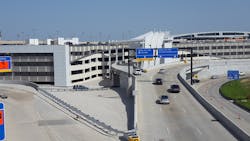Modernizing Terminal Parking and Customer Efficiency at the World’s Third-Busiest Airport
In 2011, Dallas Fort Worth International Airport (DFW) embarked on a massive renovation project called Terminal Renewal and Improvement Program (TRIP) for the interior and exterior renovation of three terminals – A, B and E. McCarthy Building Companies was selected to construct a new 1.6-million-square-foot Enhanced Parking Structure (EPS) at Terminal E in conjunction with improvements being made inside the terminal. The garage - with 3,963 spaces - was designed to bring aesthetic improvements to an aging infrastructure and increase parking availability, all while improving both the overall experience of passengers and operational efficiency of the airlines.
DFW’s goals for the design and construction of the EPS project were to:
- Provide passengers with a modern and rewarding travel experience
- Replace two aging, low-clearance, dimly lit garages with one large, well-lit and efficient, modern parking structure
- Utilize the latest parking technology to improve terminal operational efficiency
- Optimize passengers’ time spent searching for available parking
- Create a safe public space using lighting, technology and a fire protection system easily accessible to DFW emergency personnel.
“The Terminal Renewal and Improvement Program is one of DFW’s investments for the future of the airport. These improvements make DFW more competitive and customer friendly in the global marketplace,” said Nate Smith, vice president for design, code and construction at DFW. “The new parking structures are critical components to the future of the airport.”
With 65 million passengers a year flowing through DFW and a track record for exemplary customer service, airport executives challenged project planners to maintain seamless terminal operations and passenger flow during construction.
McCarthy strives for an exceptional customer experience for our clients and we had to marry that value with DFW’s expectation for its customers as well. In planning, we started viewing the construction site and the surrounding area from the customer’s perspective and considering their concern of how to travel through construction and to safely arrive at the terminal and gate.
Traveling Public on All Four Sides
About 10,000 people travel through Terminal E daily with traffic flowing 24 hours a day, seven days a week. The EPS was a two-year, phased construction project with a scope that included removal of existing roadways, construction of new bridges and utilities, and demolition of existing garage before new garage construction could begin – all to happen in the middle of this traffic flow.
I liken the construction site to a castle surrounded by a moat. The castle is the site and the moat is the public traveling around it.
Due to the limited site access and the potential safety issues traffic presented, McCarthy put a lot of thought, resources and employee training into how to safely move the public around the job site and coordinate a 350-plus person workforce getting to and from the site each day. McCarthy implemented extensive traffic control planning, including coordination with multiple contractors and airport departments involved in separate terminal renovation projects to properly prepare for thousands of deliveries, crane lifts and concrete pours while minimizing disturbance to public traffic. Due to the tight site, McCarthy planned for off-site staging and just-in-time delivery of materials. McCarthy used tower cranes with the capacity to reach over adjoining roadways and pick materials from the off-site yard and off-load trucks and fly materials into “the castle.” Crews conducted round the clock demolition and haul off of materials but limited work adjacent to and over the top of roadways to a three-hour nightshift window.
The activity and equipment in a construction zone tend to pique the public’s curiosity. To minimize the distractions that a construction zone can present to drivers and pedestrians, we hung dust barriers around the site to limit the public’s view. We also placed barricades on upper and lower terminal roads to serve as delineation for public traffic.
Beyond these measures, McCarthy worked to minimize the impacts on the driving public including limiting road closures to 60 seconds but only in between the hours of 1 a.m. and 5 a.m. McCarthy also employed the use of soil nail wall excavations to prevent the constriction of public roadways and subsequent traffic back-ups. No customer wants to be delayed on the way to catch their flight, so this was always at the forefront of construction planning.
Safety on job sites is the No. 1 priority for McCarthy and for the EPS project, and that extended to the traveling public. We are very pleased to say that there were no incidents with the public at the job site during the two-and-half-year project.
“The Terminal EPS crew went out of their way to ensure public safety as they drove and walked through construction to get into the terminal. Passengers were able to get to their flights with little feedback to the airport and that is highly unusual,” said Bobby Rodriquez, assistant vice president Code, Construction and Survey, DFW International Airport. “Further, McCarthy had the best safety rates out of the three terminal construction sites.”
Schedule Certainty
TRIP construction milestones were set in stone. Completion of each phase of the project had to be concurrent with terminal renovations of corresponding airline gates. This ensured passengers could still park adjacent to their terminal gates. These immovable milestones left McCarthy with a very tight schedule – a little more than two years to complete the $100 million project. Per the plan, McCarthy fast tracked the job with a six-day work week with double shifts each day. They also implemented ‘pull scheduling’ to organize subcontractors as well as used week-by-week logistic plans to schedule different kinds of work that coincided with each other. However, McCarthy couldn’t have planned on Mother Nature.
“We experienced 40 days of rain delay in Phase 1. There was not room in the schedule for weather so we got smart – we brought in larger drainage piping, pumped water out of the site, used a special fill that let us get back to work faster after rain and sped up concrete pour cycles.”
In 14 months, the McCarthy team turned over Phase 1 of the EPS to the airport. This first section of the parking garage offered just over 2,000 parking spaces for passengers traveling through 24 gates at Terminal E. It also provided DFW International Airport a 12-month head start on parking revenue while Phase 2 of construction was continuing.
When Phase 1 was open to the public, McCarthy noticed needed improvements on the design which would allow for drivers to more safely enter/exit the garage. The airport agreed with the design modification recommendations and had them added in Phase 1 and implemented them in Phase 2.
“DFW and McCarthy partnered on design changes early in Phase 2 that would improve the driver experience and are pleased that these changes did not affect the timeline and cost,” said Smith.
Thirteen months later, Phase 2 - the remaining 1,800 parking spaces - of the EPS was complete, coinciding with the completed renovations at the remaining 14gates in Terminal E.
Modern Garage Design for Customer Efficiency
Despite challenges, McCarthy brought innovative practices to the job with each step to provide DFW International Airport with a parking structure that delivered on goals and on time. Terminal E now boasts a modern parking structure with a Helix Access Ramp and parking guidance system that optimizes customers’ time and airport operations. DFW International Airport blogs have public input raving about the ease of use.
Although a challenging structural element to construct, the Helix Access Ramp system has proven to be one of the most efficient design features of the EPS, as it relates to minimizing customer travel time. They get to their open parking space almost in a direct line, as a result of the real-time signage and Parking Guidance System.
Comprised of two five-story cast-in-place, post-tensioned concrete ramps that intertwine (one for ascending traffic, the other for descending traffic), the Helix structure is essentially a series of three-dimensional traffic circles, with vehicles yielding to ramp traffic at each level before entering the Helix to access another level of the EPS. This design limits the vertical pathway for vehicles to a much smaller footprint than conventional parking garage ramps that often run the entire length of the garage and tend to get backed up as vehicles attempt to make hairpin turns at switchback locations. The use of the Helix system ensures a steady flow of passenger traffic and eliminates ‘traffic jams.’
The EPS features a parking guidance system which assists passengers in quickly navigating to and identifying, available parking spaces after entering the garage. A collaborative network of real-time overhead indicator lights and digital signage directs vehicles to the closest available space (including standard, one-hour and accessible parking).
One of the most exciting applications of the Parking Guidance System is the ability to use data collected from the overhead sensors and EPS capacity counts to enhance operational efficiency inside the terminal. A feedback loop between the PGS sensors and passenger ticketing kiosks inside the terminal can assist airlines and the TSA by predicting staffing requirements.
“Overall, the new parking facilities at Terminal E provide an improved experience for our customers. From the well-lit corridors, to the elevators, to the ease of finding a parking spot with the parking guidance system, everyone’s favorite feature, these improvements are continuing DFW’s vision of transforming travel,” said Smith.
Mike Uldrich is a project director for McCarthy’s Texas division and leads design-build, privately financed projects, specifically providing parking garage solutions to clients within sectors such as Aviation, Municipalities and Higher Education. Uldrich is a 23-year McCarthy “lifer” who studied Architectural Engineering at University of Texas, Austin, focusing on Construction Management.
About the Author

